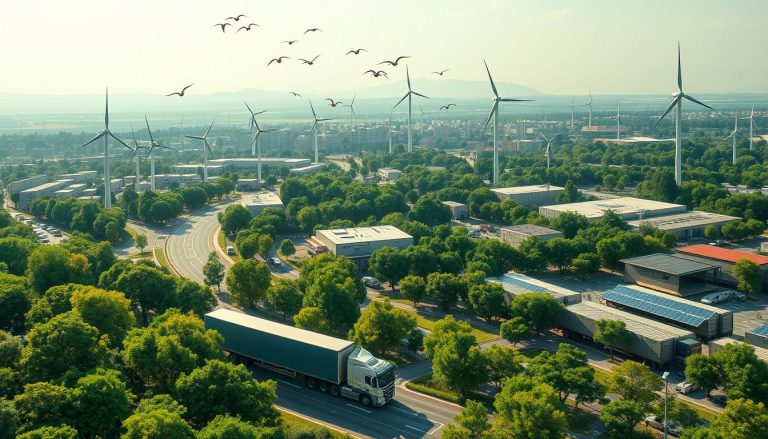Discover the Different Types of Warehouses
In the U.S., supply chains depend on accurate warehouse classification to manage costs, speed, and service levels. This guide outlines the primary warehouse categories. It explains how each supports storage, throughput, and value-added activities. It also examines cost structures, operational risks, and regulatory requirements for various warehouse types used by retailers, manufacturers, and 3PLs.
The analysis covers a range of warehouse types, including distribution centers, fulfillment centers, cold storage, bulk storage, cross-docking, and transloading sites. It also looks at public, private, contract, cooperative, bonded, government, FDA-certified, hazmat, reverse logistics, consolidation, and smart or automated facilities. It references practices at Walmart, Amazon, Lineage Logistics, Kesko’s AutoStore, Best Buy’s AutoStore deployments, and Medline’s LEED-certified facility in Hammond, Louisiana.
Readers will find detailed comparisons of different warehouse types. These comparisons are based on inventory turnover, SKU diversity, seasonality, and proximity to demand and transport nodes. They also consider technology readiness, capital intensity, and compliance. The sections ahead connect these factors to measurable outcomes in labor, transportation, energy use, and customer service. Throughout, the article uses consistent warehouse classification terms to help decision-makers choose the right facility for their needs.
Expect concise definitions, real-world examples, and data-driven guidance. The goal is to show how facility design and location impact cost-to-serve, delivery speed, and resilience across the United States.
What Is a Warehouse? Core Functions, Warehouse Classification, and Supply Chain Roles
A warehouse is a critical node in the supply chain, balancing cost, speed, and service. It supports storage, product flow, and operational execution. Companies choose from various warehouse types based on demand patterns, risk tolerance, and service-level targets.
Design and layout are key in different warehouse classifications, influencing labor productivity, handling costs, and on-time delivery. A warehouse management system (WMS), slotting logic, and standardized workflows are used to control accuracy, safety, and inventory integrity. These elements help determine the best warehouse option for each network.
Storage, throughput, and value-added services
Warehouses have three main functions. First, they act as buffers between supply and demand, handling short-term to long-term storage. Second, they accelerate product movement through receiving, putaway, picking, and shipping. Third, they offer value-added services like cycle counting, kitting, and transportation coordination, often provided by public and contract operators.
Different warehouse styles focus on various roles. Distribution centers aim for rapid flow to reduce lead times. Fulfillment centers prioritize order accuracy and returns control. Cold facilities manage temperature and humidity for perishable goods. Bulk sites handle large volumes of single-SKU or raw materials near production plants.
How warehouse categories align with business models
Alignment starts with the go-to-market model. E-commerce brands need fulfillment operations for same-day cutoffs and parcel optimization. Heavy industry and commodity producers benefit from bulk storage near plants. Perishables require cold environments with HACCP and continuous monitoring. Hybrid nodes combine flow and storage for omnichannel support.
Ownership and operating choices are also critical. Private facilities offer control and customization for one company. Public sites provide shared capacity for a fee. Contract agreements leverage dedicated 3PL operations under service-level commitments. Cooperative structures pool volume and share costs among members, improving utilization.
Key factors: inventory turnover, SKU diversity, seasonality, geography
Selection criteria include turnover rates, SKU breadth, order volume, and variability. High-turnover profiles benefit from cross-docking or fast-pick fulfillment. Low-turnover assortments lean toward deep reserve storage. Broad catalogs require refined slotting and replenishment logic to protect pick density and accuracy.
Seasonality and geography influence warehouse options and labor plans. Peak demand requires temporary capacity, flexible staffing, and extended shifts. Proximity to customers, ports, rail ramps, and interstate corridors reduces transportation costs and cycle times. Technology—WMS, robotics, and IoT—raises accuracy and speed, offsetting higher capital with lower unit operating costs across various warehouse classifications and styles.
Distribution Centers for Speed: Warehouse Styles Optimized for Rapid Flow
Distribution centers are key nodes in logistics, aiming to reduce delivery times and distances. They focus on quick processing, not on storing goods for long. This approach invests in systems like conveyors and data management. These centers handle fast-moving items and urgent orders, making delivery times shorter.
Strategic siting to cut transportation costs and delivery times
DCs are strategically placed near population centers and major transportation hubs. This reduces the distance and time needed for last-mile delivery. By locating warehouses in optimal spots, fuel and labor costs per order decrease. This strategy balances speed with efficiency in freight handling.
High-velocity receiving, sorting, and shipping workflows
DCs focus on quick and efficient handling of goods. Goods are checked immediately after arrival and then placed in areas for easy picking. This setup, driven by warehouse management systems, minimizes travel and increases productivity. It ensures accuracy and flexibility, even during peak periods.
- Inbound: appointment scheduling, ASN validation, and rapid unload to staging.
- Processing: automated sortation, zone picking, and real-time exception handling.
- Outbound: route-based consolidation, parcel induction, and dock scheduling.
Real-world example: Walmart’s regional distribution network
Walmart uses regional distribution centers for frequent restocking. High-turn items are moved quickly, with minimal storage. Best Buy’s use of AutoStore in its DCs shows how automation boosts efficiency and meets next-day delivery goals. This supports the need for fast, efficient warehouse operations.
| Design Focus | Operational Impact | Technology Enablers | Cost Profile |
|---|---|---|---|
| Proximity to demand clusters | Shorter lead times and fewer linehaul miles | Network modeling and transportation optimization | Lower outbound cost per unit |
| Cross-dock and forward pick zones | Reduced dwell and higher turns for fast movers | WMS slotting, flow-through rules, RF scanning | Moderate capital, rapid payback |
| Goods-to-person and conveyor sortation | Higher picks per hour and stable cycle times | AutoStore, put-to-light, automated cartonization | Material handling investment vs. storage density |
| Real-time visibility and QC gates | Lower errors and improved on-time departure | WES/WMS integration, labor management systems | Cost control via accuracy and throughput |
Fulfillment Centers for E-commerce: Warehouse Varieties Built for Order Accuracy
Fulfillment centers are designed for fast, precise delivery to consumers. They match warehouse layouts with high service standards, real-time inventory checks, and readiness for the final delivery step. These facilities are ideal for brands with many products and changing demand across the country.
Picking, packing, returns, and last-mile readiness
They focus on efficient picking, accurate packing, and handling returns. Barcode scans verify each item, reducing errors. Integrated returns systems inspect, grade, and quickly restock items.
By locating near major cities and carrier hubs, they reduce delivery costs and improve on-time delivery. This is key for same-day and next-day services across various warehouse types.
Automation and robotics for fast order turnaround
Automation and robotics increase efficiency without raising error rates. Goods-to-person systems, AMRs, and automated sorters enable dense storage and quick picking. Smart cartonization and label automation also speed up the handover to carriers, reducing waste.
Warehouse management software coordinates labor and inventory across different locations. This enhances visibility, supports multiple sales channels, and allows for scalable warehouse setups without performance drops as orders increase.
Real-world example: Amazon fulfillment and metro e-commerce hubs
Amazon uses mobile robots, real-time slotting, and automated sorting to speed up picking and packing for Prime. Their warehouses focus on scan-based management, heat mapping, and dynamic labor allocation.
Best Buy’s urban centers employ AutoStore for dense, fast fulfillment and next-day delivery. Third-party services like ShipBob operate distributed nodes and cloud WMS to reduce shipping zones and times. They align warehouse designs with the demands of omnichannel sales.
Cold Storage Warehouses: Warehouse Options for Perishables and Pharma
Cold storage facilities cater to food producers, grocery stores, and healthcare distributors. They require precise control over environmental conditions. Design choices are guided by clear specifications, including insulation, floor heating, and more. Operators compare various warehouse types to assess energy use, throughput, and compliance needs.
Today’s facilities focus on energy-efficient refrigeration, LED lighting, and dense layouts. These options balance product quality, labor safety, and cost. Investments are made in airflow management, sealed docks, and digital monitoring for ongoing verification.
Temperature and humidity control requirements
Temperature ranges vary from -10°F to -20°F for deep-freezing to 59–77°F for pharmaceuticals. Humidity targets range from 85–95% for produce to below 50% for packaging stability. Warehouse specifications include sensor density, door cycles, and defrost schedules to manage moisture and ice.
Validated mapping ensures uniformity in racking and aisles. Air curtains, rapid-roll doors, and vestibules limit infiltration at docks. Continuous logging supports FDA and USDA audits and aligns with Good Distribution Practice for drug products.
Automation advantages in frozen and chilled environments
Automation reduces human exposure to subzero zones and stabilizes output during peak demand. AS/RS, shuttle systems, and robotic palletizing sustain steady flows while trimming energy loss from door openings. These options also enable narrow aisles and higher racks, yielding more pallets per cubic foot.
- Worker safety: Fewer entries into harsh zones cut risk and fatigue.
- Energy efficiency: Optimized travel paths and door cycles lower compressor load.
- Quality control: Precise placement and rapid retrieval reduce dwell time variance.
- Space utilization: High-density storage boosts capacity within existing footprints.
Real-world example: Lineage Logistics and Kesko’s chilled AutoStore
Lineage Logistics operates large-scale cold storage serving national food brands. They use high-density designs and data-driven energy controls to conserve power while maintaining product integrity. In Helsinki, Kesko deployed ambient and chilled AutoStore systems for grocery e-commerce, doubling daily delivery capacity, cutting same-day delivery to six hours or less, and reducing in-store picking labor by 80%.
Healthcare distributors have also advanced energy performance. Medline’s LEED-certified site in Hammond, Louisiana, demonstrates how efficient envelopes, lighting, and refrigeration strategies meet strict warehouse specifications while supporting temperature-sensitive SKUs.
| Criteria | Chilled (33–41°F) | Frozen (0°F to -20°F) | Controlled Room (59–77°F) | Operational Implications |
|---|---|---|---|---|
| Primary Use | Dairy, produce, ready-to-eat items | Meat, seafood, ice cream | Pharma, nutraceuticals, select OTC | Select different warehouse types based on product risk and shelf life |
| Humidity Target | High for produce; moderated for packaged foods | Low to prevent frost and ice buildup | Moderate for packaging stability | Humidity control reduces spoilage and packaging damage |
| Automation Fit | Strong for case and tote handling | Very strong; minimizes human exposure | Strong with validation-friendly tracking | Automation improves throughput and traceability |
| Energy Profile | Medium; focus on door control | High; demands tight insulation and dock design | Low to medium; HVAC zoning critical | Efficiency gains from heat recovery and LED lighting |
| Compliance Focus | USDA, food safety audits | USDA, HACCP controls | GDP and temperature mapping for pharma | Robust monitoring embedded in warehouse options |
Decision-makers should benchmark automation payback, energy intensity per cubic foot, and labor exposure hours. Aligning warehouse specifications with SKU profiles ensures the right mix of different warehouse types across the network. This improves service levels while managing total cost to serve.
Cross-Docking and Transloading Centers: Different Warehouse Types for Minimal Storage
These fast-turn nodes sit within warehouse categories focused on flow, not stock. They fit warehouse varieties that compress dwell time, cut handling, and keep freight moving. In various warehouse classifications, they operate as bridge points between carriers, modes, and networks.
Cross-docking vs. transloading: core differences
Cross-docking moves freight from inbound to outbound doors with near-zero storage. Pallets or cartons transfer through sorting, staging, and immediate dispatch. This approach supports fast-moving SKUs and synchronized schedules.
Transloading shifts loads between modes, such as ocean to truck or rail to truck. Port-centric hubs near Los Angeles, Long Beach, Savannah, and New York–New Jersey rely on this capability. It extends reach inland while aligning with warehouse categories that favor minimal inventory.
Both models appear in hybrid distribution centers run by brands like Walmart and Target. They also show up in third-party logistics networks managed by DHL Supply Chain, Ryder, and XPO. These warehouse varieties emphasize throughput, dock density, and reliable carrier slots.
Just-in-time flows and inventory holding cost reductions
With precise scheduling and slot control, cross-docking and transloading reduce carrying costs. Goods avoid long-term storage, trimming capital tied up in stock. As a result, order cycle times compress when demand signals are steady and suppliers are on time.
Operations teams use wave plans, ASN accuracy, and yard management to keep docks fluid. Real-time visibility from RFID or IoT sensors improves staging accuracy. In various warehouse classifications, these nodes act as velocity filters that protect network speed.
Use cases: perishable goods and rapid transit operations
Perishables—produce, dairy, meat, and floral—benefit from fewer touches and faster turns. Cross-border e-commerce, seasonal promotions, and retail resets gain speed with mode shifts. Parcel inject programs and middle-mile transfers also rely on these fast-switch sites.
Carriers serving grocery chains and quick-service restaurants use dock-to-dock flows to meet shelf-life targets. Transloading supports import peak season by relieving port congestion and balancing capacity. These warehouse varieties fit warehouse categories where time sensitivity is high.
| Dimension | Cross-Docking | Transloading | Operational Implication |
|---|---|---|---|
| Primary Objective | Immediate transfer to outbound trailers | Mode change (ocean/rail to truck, or truck to rail) | Minimize dwell while matching carrier and mode capacity |
| Typical Dwell Time | Less than 24 hours | 24–72 hours, driven by customs, drayage, or rail schedules | Short stays reduce carrying cost and labor touches |
| Infrastructure Focus | High door count, fast sortation, staging zones | Container yards, chassis access, transload bays | Dock density and yard control drive throughput |
| Network Role | Velocity hub for fast-moving SKUs | Port-to-inland bridge for import/export flows | Aligns with various warehouse classifications stressing flow |
| Ideal Freight | Retail replenishment, parcel inject, JIT components | International containers, bulk-to-pallet conversion | Supports warehouse varieties requiring rapid transit |
| Key Controls | Precise appointment times, ASN accuracy, cross-dock planograms | Container availability, drayage timing, customs clearance | Scheduling discipline ensures consistent service levels |
Positioned within warehouse categories that prioritize speed, these centers streamline handoffs and constrain costs. By aligning network design with various warehouse classifications, operators select warehouse varieties that keep goods in motion and service metrics stable.
Private, Public, Contract, and Cooperative: Various Warehouse Classifications for Control and Flexibility
Ownership and operating models define control, cost, and agility. Each warehouse classification offers distinct risk profiles, service levels, and capital needs. The choice also shapes governance, data visibility, and compliance. These warehouse styles support different demand patterns and network strategies across industry sectors.
Private warehouses: customization and security for single owners
Private facilities are owned and run by one company, enabling layout design, SKU zoning, and access control. This model suits high-value inventory, stable throughput, and strict confidentiality. Firms optimize MHE, WMS rules, and audit trails to match internal standards and brand policies.
Public warehouses: fee-based, shared infrastructure
Public sites provide storage and services on a pay-per-use basis, supporting seasonal peaks and short contracts. Operators offer inventory management, order fulfillment, and transport coordination, lowering fixed assets. This warehouse classification preserves flexibility when demand is volatile.
Contract warehouses: dedicated 3PL-operated solutions
Contract arrangements assign a dedicated facility to one client, run by a third-party logistics provider under multi-year terms. This approach blends customization with outsourced labor, safety, and systems. Arvato, for example, operates an AutoStore grid for Rituals Cosmetics with a bunker for aerosols and flammables to meet compliance and performance goals.
Cooperative warehouses: pooled ownership and cost-sharing
Cooperatives combine resources from several firms to share capacity, technology, and overhead. Members gain scale while retaining joint oversight of service policies. These warehouse styles are attractive to smaller businesses that need cost control with some governance rights.
| Model | Control Level | Typical Contract | Capital Commitment | Best for Demand Pattern | Key Advantages | Primary Trade-offs |
|---|---|---|---|---|---|---|
| Private | Full operational and security control | Owned; internal SLAs | High CapEx; fixed overhead | Stable, high-volume flows | Customization, confidentiality, brand standards | Lower flexibility; utilization risk |
| Public | Shared control via provider policies | Short-term, fee-based | Low CapEx; variable Opex | Seasonal or unpredictable | Scalability, speed to start, broad services | Limited customization; multi-tenant constraints |
| Contract | High control through SLA and KPIs | Multi-year with 3PL | Moderate CapEx; committed Opex | Steady with specific requirements | Dedicated labor, tailored processes, performance guarantees | Term lock-in; transition costs |
| Cooperative | Joint governance among members | Membership or equity-based | Shared CapEx; pooled costs | Mixed volumes across firms | Economies of scale, bargaining power | Collective decision-making; allocation complexity |
In practice, firms often blend models across networks. Using various warehouse classifications enables the right balance of service, cost, and resilience. Portfolio design aligns warehouse styles with demand variability, required specialization, and capital constraints.
Bonded Warehouses: Warehouse Specifications for International Trade
Bonded warehouses are government-authorized facilities for storing imports under customs control until release. This model expands viable warehouse options for cross-border flows, keeping goods secure and traceable. Companies compare warehouse varieties based on regulatory exposure, cash timing, and handling rights to select the right fit.
Customs authorization and deferred duties
U.S. Customs and Border Protection licenses bonded sites and audits procedures, inventory records, and access controls. Duties and taxes are deferred until cargo leaves the bond for domestic sale. This structure allows limited handling—such as inspection, relabeling, or kitting—when permitted under the bond’s warehouse specifications.
Ports of entry like Los Angeles, New York–Newark, and Savannah rely on bonded capacity to stage shipments awaiting clearance. Multinationals and e-commerce brands use these warehouse options to hold large, duty-sensitive inventories without upfront tariff payments.
Cash-flow benefits for import-export operations
Deferral improves working capital by delaying duty outlays until confirmed demand. If goods are re-exported, many programs allow duty elimination on those units, reducing landed cost. These warehouse varieties support phased releases aligned with purchase orders, which stabilizes inventory turns and reduces borrowing needs.
Seasonal importers benefit by storing peak volumes under bond and drawing down stock as sales materialize. This timing flexibility helps manage foreign exchange exposure and freight variability across quarters.
Compliance considerations and typical workflows
Operations follow defined workflows: inbound receipt under bond, verification against manifests, secure storage, and controlled access with serialized location tracking. Documentation must match entry filings, with discrepancies escalated to brokers and customs officers.
Upon withdrawal, teams calculate duties, process payments, and update bond balances before release or re-export. Tight cycle counts, CCTV coverage, and audit trails are standard warehouse specifications that reduce risk and support regulatory reviews.
- Users: apparel importers, electronics brands, pharmaceutical distributors, and automotive parts networks.
- Controls: bonded seals, tamper-evident cages, and tiered user permissions in WMS platforms from providers like Manhattan Associates and Blue Yonder.
- Outcomes: better liquidity, precise customs compliance, and scalable warehouse options across major gateways.
Decision-makers evaluate warehouse varieties based on product value, tariff rate, dwell time, and forecast accuracy. A bonded model becomes most effective when duty exposure is high and demand timing is uncertain.
Specialized Warehouse Styles: Hazmat, FDA-Certified, Government, and Reverse Logistics
High-control facilities stand out due to strict regulations, risks, and public mandates. These warehouse styles operate under strict standards. This affects costs, staffing, and documentation across key warehouse categories.

Hazmat warehouses: safety, regulation, and trained personnel
Hazardous materials sites adhere to OSHA, EPA, and NFPA standards. They have segregation, spill containment, ventilation, and fire-rated construction. Trained technicians manage chemicals, lithium batteries, aerosols, and perfumes with lockout procedures and incident response plans.
Insurance premiums and permitting increase total landed cost. Companies like BASF and Dow require real-time tracking, SDS access, and audit-ready logs. This reflects a high-control segment within different warehouse types.
FDA-certified storage for regulated goods
FDA-certified facilities store foods, drugs, and medical devices under cGMP and FSMA rules. Controls include verified temperature ranges, humidity targets, sanitation cycles, and lot-level traceability with time-stamped records.
Providers such as AmerisourceBergen and UPS Healthcare use validated cold chains, serialized inventory, and documented CAPA processes. These warehouse categories emphasize condition integrity and recall readiness.
Government facilities for emergency response and surplus capacity
Federal, state, and municipal warehouses hold strategic inventories for defense, emergency response, and public health. During COVID-19, FEMA and state agencies staged PPE and ventilators for rapid deployment.
These warehouse styles prioritize continuity of operations, redundant power, and secure access. Stock rotation, cycle counts, and surge protocols support mission-critical supply flows.
Reverse logistics centers for returns, refurbishing, and recycling
Reverse hubs inspect, triage, restock, refurbish, or recycle goods at scale. Retailers like Target and Best Buy route returns to specialized nodes to recover value and cut waste.
Processes include grading, parts harvesting, certified data wipe for electronics, and channel reassignment. Within different warehouse types and warehouse categories, these warehouse styles mitigate margin erosion from high online return rates.
Bulk Storage and Consolidation Warehouses: Warehouse Options to Optimize Space and Freight
Bulk storage and consolidation sites are key to controlling costs in logistics networks. They focus on handling large volumes efficiently, with a focus on predictable flow and disciplined planning. Warehouse operators assess various specifications, such as racking types, floor loading, and cube utilization, to minimize handling and freight costs.
Bulk storage near production for raw materials and single-SKU volumes
Bulk storage facilities are strategically located near production sites to reduce inbound miles and touches. They handle large quantities of goods like grains, chemicals, and steel. The layout features wide aisles and high-bay blocks, enabling efficient single-SKU stacking and fast line feeding.
Important warehouse specifications include slab strength, dust control, spill containment for liquids, and fire protection according to NFPA standards. Being close to manufacturers like Archer Daniels Midland mills or Dow Chemical sites helps in reducing dwell time. This stabilizes takt-driven replenishment processes.
Consolidation hubs to reduce shipping costs
Consolidation warehouses combine small shipments from multiple suppliers into full truckloads or rail moves. This approach increases cube utilization and lowers costs per unit by avoiding partial loads. Retailers and brands use regional hubs near major corridors like I-80 and I-95 to balance speed with scale.
Carriers benefit from material savings when loads are optimized for mode. These warehouses often use dynamic slotting and pallet reconfiguration to meet carrier rules while protecting product integrity.
Planning requirements for multi-supplier aggregation
Effective aggregation requires precise orchestration. Schedulers align supplier appointments, ASN accuracy, and cartonization rules to manage variability. Load planning tools in WMS or TMS support wave building, cube calculators, and trailer sequencing.
To ensure service, operators track dwell, dock cycle time, and OTIF metrics. Clear policies define labeling, pallet quality, and appointment windows. With scalable docks, cross-dock lanes, and visibility dashboards, teams reduce detention risk and maintain on-time departures.
- Core capabilities: appointment scheduling, ASN validation, cartonization logic
- Operational metrics: OTIF, trailer fill rate, dock-to-stock time
- Infrastructure: high-bay storage, spill-safe zones, flexible staging areas
- Systems: integrated WMS/TMS, slotting analytics, load optimization
Smart and Automated Facilities: Warehouse Varieties Leveraging Robotics, AI, and IoT
Robotics, AI, machine learning, and IoT are transforming warehouse operations. Automated sorting, picking, and packing are now common. Cloud-based WMS from companies like Manhattan Associates and Blue Yonder integrate these technologies for real-time control. This results in faster throughput, higher order accuracy, and scalable capacity. Yet, it requires significant upfront investment and technical expertise.
Amazon Robotics and AutoStore are leading the way with significant improvements in speed and reliability. Best Buy’s AutoStore deployments have shown how compact grids can reduce travel time and errors. These innovations align with the need for omnichannel fulfillment. Orchestration tools help manage inbound, slotting, and last-mile dispatch, ensuring stable service levels during peak demand.
Real-time inventory visibility and automated picking
IoT tags, computer vision, and autonomous mobile robots track inventory at the bin and SKU level. Cloud WMS and digital twins provide live stock positions and exception alerts. Automated picking solutions, from goods-to-person grids to AMRs, reduce dwell time and mispicks. This improves labor safety across various warehouse types.
- Live dashboards consolidate cycle counts, slotting heat maps, and order backlogs.
- Pick-to-light and voice systems raise accuracy above manual baselines.
- API-based feeds support omnichannel promises such as same-day cutoffs.
Energy efficiency and space optimization in automated cold storage
Automated cold environments use dense racking, shuttle systems, and AutoStore cubes to maximize space. Kesko’s chilled AutoStore showcases high-density storage and precise temperature control. This limits door openings and air exchange, reducing energy consumption and improving worker safety.
- Variable-speed compressors and LED lighting cut energy intensity.
- High-density layouts shrink building footprints and refrigerant load.
- Closed-loop monitoring maintains humidity and temperature compliance.
When to invest in high-tech warehouse specifications
Investment in high-tech warehouse solutions is justified when order volumes increase, labor markets tighten, and SKU complexity grows. Service-level targets, such as same-day or next-day delivery, benefit from goods-to-person and AMR fleets. Companies evaluate the payback from reduced operating costs, lower error rates, and higher productivity.
- Trigger points: sustained volume growth, overtime reliance, and accuracy penalties.
- Key metrics: picks per hour, cost per order, and space utilization ratio.
- Fit check: integration maturity across warehouse categories and network nodes.
How to Choose Among the Types of Warehouse
Choosing a warehouse starts with aligning business goals with a specific classification. Assess SKU variety, turnover, order size, and seasonal patterns. Then, match site roles with service goals and budget constraints. Distributed networks, like those of Best Buy and Amazon, showcase how metro nodes reduce transit times and freight costs.
Aligning warehouse classification with cost, capacity, and service levels
Balance capital, throughput, and delivery speed promises. Private facilities offer control and data security but require significant upfront investment and efficient use. Public and contract sites provide flexibility and specialized labor, converting fixed costs to variable.
Bonded locations support import flows by deferring duties and smoothing cash cycles. Specialized facilities meet regulatory needs for hazardous materials and FDA-regulated items. Scenario analysis helps test lane costs, facility throughput, and WMS integration across different warehouse classifications.
Customer-centric logistics: network design and geographic reach
Place nodes near demand to shorten delivery times and lower parcel costs. Regional DCs paired with urban fulfillment points enable next-day delivery and reduce split shipments. This structure supports e-commerce peaks and store replenishment within one network.
Model node count against transportation spend and cycle time. Compare cross-docking for fast movers with storage for slower SKUs. Select warehouse types that match local courier density and carrier performance by metro.
Scalability, sustainability, and hybrid warehousing trends
Design for growth with modular racking, multi-node orchestration, and API-ready WMS. Hybrid sites combine distribution and fulfillment, improving responsiveness, reducing redundancy, and enabling cross-docking during demand spikes.
Prioritize energy-efficient systems, LEED-ready designs, and automation in cold storage to cut power use. Include resilience measures for severe weather and grid interruptions. Ensure technology interoperability so upgrades do not disrupt service levels across the network.
| Decision Dimension | Preferred types of warehouse | Primary Benefits | Key Trade-offs | Best-Fit Use Cases |
|---|---|---|---|---|
| Cost Structure | Public or contract | Variable cost, expert labor, rapid start-up | Less direct control, SLA dependence | Seasonal peaks, new markets, testing demand |
| Control & Security | Private | Process control, data governance, customized layouts | Higher capex, longer ramp time | Proprietary flows, high-value goods, stable volumes |
| Trade & Cash Flow | Bonded | Deferred duties, improved cash cycle | Compliance overhead, limited activities | Import-heavy SKUs, long dwell before sale |
| Speed to Customer | Distributed DCs + metro fulfillment | Shorter lead times, fewer split shipments | Higher network complexity | Next-day targets, dense urban demand |
| Regulatory Needs | Specialized (hazmat, FDA-certified) | Compliance, trained staff, audited processes | Higher operating costs | Pharma, chemicals, temperature-sensitive items |
| Scalability | Hybrid with 3PL-operated nodes | Flexible capacity, multi-client synergies | Shared resources during peaks | E-commerce growth, variable seasonality |
| Technology Integration | WMS-integrated facilities (API-ready) | Real-time visibility, faster onboarding | Upfront integration work | Omnichannel orchestration, multi-node networks |
Use this framework to match warehouse classification to demand profiles, transportation spend, and service metrics. Validate choices with throughput modeling, carrier performance data, and ROI tests for automation. The outcome is a calibrated selection across various warehouse classifications that supports growth and reliability.
Conclusion
U.S. supply chains depend on a variety of warehouses, from high-throughput centers to specialized facilities. These include cold storage, bulk storage, and cross-docking hubs. Each type addresses different needs, such as compliance and risk management.
Ownership models also play a role, influencing costs and control. Private, public, contract, and cooperative models vary in capital intensity and scalability. This diversity allows for tailored solutions across the spectrum of warehouse types.
Studies highlight the benefits of these warehouse varieties. Walmart’s regional DC network has improved replenishment speed and reduced transport miles. Amazon’s automated fulfillment has increased accuracy and reduced cycle times.
Best Buy’s use of AutoStore in DCs and metro hubs supports next-day delivery. Lineage Logistics has expanded its temperature-controlled capacity in key markets. Kesko’s chilled AutoStore has significantly reduced in-store picking labor and delivery times.
Investment in technology, such as robotics and AI, enhances warehouse performance. It improves throughput, accuracy, and energy efficiency. While initial costs are higher, the total cost to serve often decreases when systems match SKU profiles and order patterns.
The right mix of warehouse types balances speed, cost, and risk. It also meets regulatory standards and sustainability goals. This selection should align with the business model, demand geography, and customer expectations.
Many networks now combine different warehouse types across various locations. This approach helps mitigate disruption and supports growth. A hybrid strategy, based on data analysis, ensures resilient operations and measurable ROI.
FAQ
What are the main types of warehouse and how do warehouse categories map to core functions?
The main warehouse types include distribution centers, fulfillment centers, and cold storage facilities. Bulk storage, cross-docking, and transloading centers also exist. Public, private, contract, cooperative, bonded, government, FDA-certified, and hazmat warehouses are among the others. Each type serves a specific purpose, from storage to value-added services.
Choosing the right type depends on factors like turnover, SKU diversity, and seasonality. Regulatory needs and proximity to demand and transport nodes also play a role.
How do distribution centers differ from fulfillment centers in warehouse classification and cost structure?
Distribution centers focus on high-throughput receiving, sortation, and shipping. They aim to reduce linehaul costs and cycle times. Located near major corridors, they use cross-dock zones for fast movers.
Fulfillment centers, on the other hand, prioritize order accuracy and rapid picking and packing. They are key for e-commerce, focusing on last-mile speed. Examples include Walmart’s regional DCs and Amazon’s fulfillment centers.
When should a business choose cold storage, bulk storage, or consolidation warehouses among different warehouse types?
Cold storage is ideal for temperature- and humidity-controlled goods like perishables and pharmaceuticals. Lineage Logistics and Kesko’s chilled AutoStore show its benefits in safety, energy efficiency, and speed.
Bulk storage is best for single-SKU or raw material volumes with low turnover and stable demand. It’s often located near production sites.
Consolidation warehouses are great for aggregating multi-supplier inbound into fuller, lower-cost outbound loads. They reduce freight spend through better cube utilization and fewer partial shipments.
What are the ownership and operating options across various warehouse classifications, and who benefits from each?
Private warehouses offer full control, customization, and security for stable, high-volume operations. Public warehouses provide fee-based shared capacity and value-added services, ideal for seasonal or temporary needs.
Contract warehouses are dedicated, 3PL-operated sites under long-term agreements. They blend customization with outsourced expertise, as seen in Arvato’s operations for Rituals Cosmetics. Cooperative warehouses pool ownership to share costs and scale capabilities, supporting smaller firms seeking control with affordability.
How do bonded, hazmat, FDA-certified, and government warehouses fit into warehouse options and specifications?
Bonded warehouses allow duty deferral under customs supervision to improve import-export cash flow and manage large, duty-intensive inventories. Hazmat warehouses handle dangerous goods with specialized infrastructure and trained staff under strict regulations.
FDA-certified facilities store regulated food, drugs, and devices with documented environmental controls and traceability. Government warehouses support emergency response, public services, and surplus management, as seen during large-scale crises like the COVID-19 pandemic.
What defines smart or automated facilities, and when do the economics favor investment in these warehouse styles?
Smart warehouses use robotics, AI, machine learning, and IoT to automate picking, packing, and real-time inventory tracking via WMS integration. They offer faster throughput, higher accuracy, and scalable capacity.
Investment is justified when order volumes are rising, labor markets are tight, SKU complexity is high, and service levels target same-day or next-day delivery. Best Buy’s AutoStore deployments and Amazon’s robotics are examples.
How should companies choose among the different warehouse types to balance cost, speed, and service levels?
Align your business model with the warehouse type: consider SKU breadth, turnover, order profile, and seasonality. Evaluate geography for proximity to customers and transport nodes, and test multi-node designs for next-day reach.
Assess capital intensity versus flexibility across private, public, contract, and cooperative models. Incorporate regulatory needs for bonded, FDA-certified, and hazmat sites. Model technology ROI for automation, including energy efficiency gains in cold storage.
Many operators adopt hybrid networks blending distribution and fulfillment to improve responsiveness and resilience.






